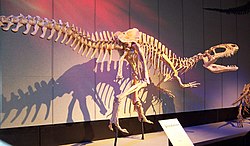Metriacanthosauridae
| Metriacanthosaurids | |
|---|---|

| |
| Sinraptor dongi, Royal Tyrrell Museum | |
| Scientific classification | |
| Domain: | Eukaryota |
| Kingdom: | Animalia |
| Phylum: | Chordata |
| Clade: | Dinosauria |
| Clade: | Saurischia |
| Clade: | Theropoda |
| Clade: | †Carnosauria |
| Superfamily: | †Allosauroidea |
| Family: | †Metriacanthosauridae Paul, 1988 |
| Type species | |
| † Metriacanthosaurus parkeri
, 1923 | |
| Subgroups | |
| |
| Synonyms | |
| |
Metriacanthosauridae is an
Diagnostic traits
Metriacanthosaurids share the following unambiguous
- A short or absent anterior ramus of the maxilla (also found in carcharodontosaurids and piatnitzkysaurids).
- The laterosphenoid articulated on the frontal and postorbital.
- A squamosal without constriction of the lower temporal fenestra. (also found in megalosauroids)
- A flange on the squamosal covering the quadrate head laterally.
- A well-defined longitudinal groove on the lateral side of the dentary housing a row of neurovascular foramina.
- Broad, well developed spinopost-zygapophyseal lamina on the axis.
- A manus shorter than the forearm.
- Subrectangular and sheet-like neural spines of middle caudal vertebrae.
- A manus without digit V or the phalanges of digit IV (also found in neovenatorids).
- A heart-shaped cross section of the ilium's paired midshafts (also found in coelophysids).
- Fused distal end of the ischium (also found in neovenatorids and basal tetanurans).
Metriacanthosaurids share the following dental synapomorphies among theropods:[4]
- surface centrally positioned on the labial surface of the crown roughly flattened in lateral teeth
- irregular and non-oriented enamel surface texture
Metriacanthosaurines share the following synapomorphies among metriacanthosaurids:[2]
- The anteroventral border of the maxillary antorbital fenestra being demarcated by a raised ridge (also found in Eoraptor, coelophysids, Masiakasaurus, Marshosaurus, and Compsognathus).
- A pronounced ventral keel on the anterior dorsal vertebrae (also found in Condorraptor, Piatnitzkysaurus, Carcharodontosaurus and many megalosaurians).
- A straight posterior margin of the iliac postacetabular process.
- The angle between the long axes of the pubic shaft and boot being less than 60 degrees.
- A ventrally curved ischial shaft (also found in coelophysids, Eustreptospondylus, Afrovenator, Megalosaurus and Compsognathus).
- A bulbous fibular crest on the tibia (also found in Sinosaurus).
Classification
Carrano, Benson & Sampson (2012) noted that the name Metriacanthosauridae should be used as it has priority over Sinraptoridae.[2] Cladistically, Sinraptoridae had been latest defined in 2005 by Paul Sereno as the most inclusive monophyletic group that contains Sinraptor dongi and all species closer to Sinraptor than to either Allosaurus fragilis, Carcharodontosaurus saharicus, or the house sparrow (Passer domesticus).[5]
Furthermore, the 2012 study named a new subfamily Metriacanthosaurinae to include all metriacanthosaurids more closely related to
| Orionides |
| ||||||||||||||||||||||||||||||||||||||||||||||||||||||||||||||||||||||||
Palaeobiogeography
Metriacanthosauridae fossils have only been found in modern
References
- PMID 31827108.
- ^ S2CID 85354215.
- ^ Bailey, Jack Bowman. "Neural Spine Elongation in Dinosaurs: Sailbacks or Buffalo-Backs?" Journal of Paleontology, vol. 71, no. 06, 1997, pp. 1124–1146., doi:10.1017/s0022336000036076.
- ISSN 1094-8074.
- ^ Sereno, Paul. "Sinraptoridae". Taxon Search. Archived from the original on 17 July 2011. Retrieved 12 December 2010.
- S2CID 22646156.
{{cite journal}}: CS1 maint: multiple names: authors list (link) Supporting Information - ^ Xu, X., and J. M. Clark. "The Presence of a Gigantic Theropod in the Jurassic Shishugou Formation, Junggar Basin, Western China." Vertebrata PalAsiatica, 46: 158–160. www.ivpp.cas.cn/cbw/gjzdwxb/xbwzxz/200811/W020090813369286986655.pdf *[1].
- S2CID 225210438.
- S2CID 247847884.
